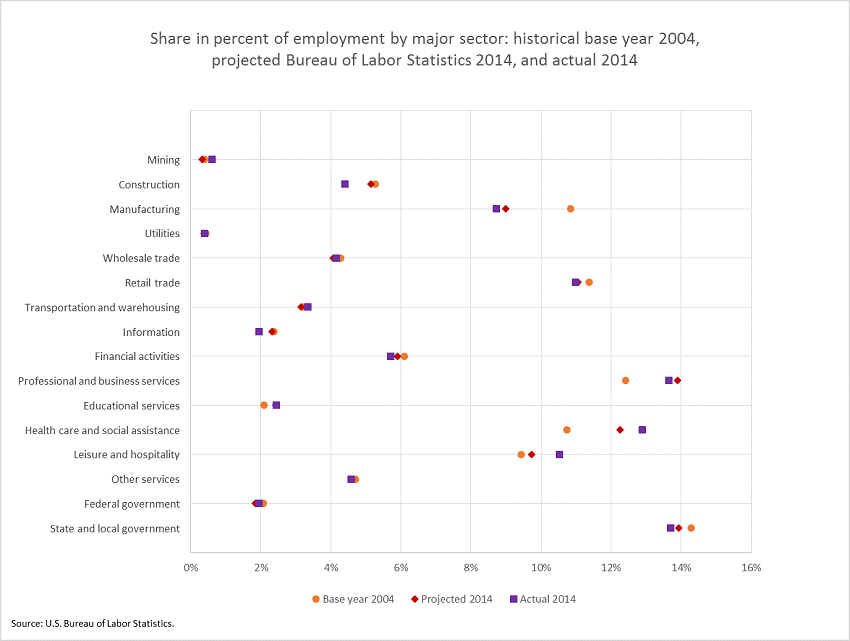An official website of the United States government
 United States Department of Labor
United States Department of Labor
BLS estimated models for hundreds of detailed industries that were then summed to subsectors and sectors1. Detailed industry projections were constrained to sum to the total nonfarm wage and salary employment provided by the macroeconomic model.
Changes to the industry classification system presented a challenge in evaluating these sets of projections. Therefore, BLS analyzed only the 16 aggregate industry major sectors rather than the detailed industries published within the projections publications. For more information, refer to our evaluation methodology.
How often did BLS correctly project growth and decline for industries?
BLS correctly projected which major industry would grow and which would decline about 75 percent of the time.
The service-producing sector, representing over 80 percent of U.S. employment, was correctly projected to experience continued growth over the 2004–14 decade. The only incorrect projections of directional change within the service sectors were in financial activities and professional and business services. Both sectors were expected to increase, but instead had slight declines. BLS correctly expected that the goods–producing sector would decline, however, BLS expected mining to decline and construction to grow, which both did the opposite.
What did BLS project as the compound annual rate of growth from 2004 to 2014?
The projected compound annual growth rate from 2004 to 2014 was 1.3 percent.
What was the actual compound annual rate of growth from 2004 to 2014?
The actual compound annual growth rate from 2004 to 2014 was 0.6 percent.
What contributed to the difference?
Since the macroeconomic model overprojected U.S. employment, industry sectors also tended to be projected higher than what was realized.
For each of the following measures the BLS projection was compared against this naïve model.
|
Sector |
Actual 2014 employment |
Employment Projections |
Absolute Percent Error |
Best Performer |
||
|---|---|---|---|---|---|---|
|
BLS |
Naïve |
BLS |
Naïve |
|||
|
Nonfarm W&S |
139,727 |
150,877 |
152,816 |
8% |
9% |
BLS |
|
Sector |
Actual 2014 employment |
Employment Projections |
Absolute Percent Error |
Best Performer |
||
|---|---|---|---|---|---|---|
|
BLS |
Naïve |
BLS |
Naïve |
|||
|
Mining |
838 |
477 |
438 |
43% |
48% |
BLS |
|
Construction |
6,151 |
7,757 |
9,139 |
26% |
49% |
BLS |
|
Manufacturing |
12,185 |
13,553 |
12,068 |
11% |
1% |
Naïve |
|
Utilities |
552 |
563 |
462 |
2% |
16% |
BLS |
|
Wholesale trade |
5,814 |
6,131 |
6,127 |
5% |
5% |
Naïve |
|
Retail trade |
15,357 |
16,683 |
16,929 |
9% |
10% |
BLS |
|
Transportation and warehousing |
4,661 |
4,756 |
4,937 |
2% |
6% |
BLS |
|
Information |
2,726 |
3,502 |
4,054 |
28% |
49% |
BLS |
|
Financial activities |
7,977 |
8,901 |
9,480 |
12% |
19% |
BLS |
|
Professional and business services |
19,062 |
20,980 |
21,464 |
10% |
13% |
BLS |
|
Educational services |
3,417 |
3,665 |
3,654 |
7% |
7% |
Naïve |
|
Health care and social assistance |
18,023 |
18,482 |
17,391 |
3% |
4% |
BLS |
|
Leisure and hospitality |
14,696 |
14,694 |
14,820 |
0% |
1% |
BLS |
|
Other services |
6,388 |
6,943 |
7,326 |
9% |
15% |
BLS |
|
Federal government |
2,733 |
2,771 |
2,480 |
1% |
9% |
BLS |
|
State and local government |
19,148 |
21,019 |
22,047 |
10% |
15% |
BLS |
The BLS model outperformed the naïve model in almost all major sectors in the absolute percent error measurement. The major sectors where the BLS model did not outperform the naïve model are wholesale trade, educational services, and leisure and hospitality.
Since aggregate employment was overprojected, detailed industries also tended to be overprojected. The projections, however, do not need to be close to the actual outcomes to be helpful to our data users in advising their career decisions. Comparing the projected share of the labor market with the actual share helps to address whether BLS correctly advised career–seeking customers which industry to pursue.
An example is in the manufacturing sector. Employment in the manufacturing sector was projected to decline 0.6 percent annually during the 2004–14 decade, making up only 9.0 percent of the total employment share by 2012. The actual employment dropped faster than expected, falling 1.6 percent annually over the projections decade. Despite the rapid decline, the sector only dropped to 8.7 percent of the total employment share in 2012, only 0.3 percent lower than projected.

1 Subsectors and sectors are aggregations of NAICS industries.
Return to Projections Evaluation Homepage
Last Modified Date: August 1, 2018